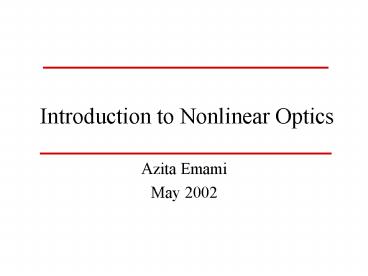Introduction to Nonlinear Optics - PowerPoint PPT Presentation
1 / 24
Title:
Introduction to Nonlinear Optics
Description:
Introduction to Nonlinear Optics Azita Emami May 2002 Outline General Introduction Photorefractive Effect Wave Mixing Phase Conjugation Stimulated Back Scattering ... – PowerPoint PPT presentation
Number of Views:1049
Avg rating:3.0/5.0
Title: Introduction to Nonlinear Optics
1
Introduction to Nonlinear Optics
- Azita Emami
- May 2002
2
Outline
- General Introduction
- Photorefractive Effect
- Wave Mixing
- Phase Conjugation
- Stimulated Back Scattering
- Other Applications
3
Introduction
- What does the index of refraction mean?
- Linear Region Efield ltlt Intra-Atomic field. n
is independent from the light intensity, I. - Nonlinear Region Efield Intra-Atomic field.
Modified electron distribution, n depends on
I.
4
Introduction (2)
- Nonlinear Optics Study of interaction of light
in matter - We can control n by the light itself or
manipulate one beam with the other. - Leads to a Great variety of technical
innovations.
5
Material Response to the Light
- P e0 c(1)E e0 c(2)EE e0 c(3)EEE
- P induced polarization of medium
- e0 dielectric constant of vacuum
- E electric field
- c(i) constant
- D e0E P eE
- In linear optics n2 1 c(1)
6
Nonlinear Terms
- Second-order term, c(2)EE
- frequency doubling
- sum/difference generation
- Third-order term, c(3)EEE
- 3rd harmonic generation
- Raman Brillouin Scattering
- Self focusing
- Optical Phase Conj.
7
Nonlinear terms (2)
- Now consider an optical beam with frequency w and
a DC field - EE0 Ewcos(wt)
- c(2) E0 Ewcos(wt)
- linear electro-optic effect discovered by
Pockels in 1883, modifying n with a DC field - used for optical switching
- used for phase modulation of light
8
More Terms
- c(2)Ew2
- static voltage appears across the sample
- c(2)Ew2 cos(2wt)
- c(3) E02 Ew cos(wt)
- quadratic electro-optic effect (DC Kerr
effect) - c(3) E0 Ew2 cos(2wt)
- c(3) Ew3 cos(3wt)
9
Last term Kerr effect
- c(3) Ew3 cos(wt) c(3) Ew2 (Ewcos(wt))
- optical (or AC) Kerr effect
- looks like a refractive index which depends
on the optical field strength - n n0n2I
- self-focusing and self-phase modulation
10
Photorefractive Effect
- Change of the local index of refraction by
illumination of a beam with spatial variation of
Intensity. - First discovered in 1966, study of laser beams
through electro-optic crystals - LiNbO3, BaTiO3, KNbO3, LiT aO3,
11
Simple Model for Photorefractive effect
- There are impurities with energy levels around
the middle of band gap (donors). - With enough photon energy, electrons get excited.
- Electrons migrate and get trapped at nearby sites
in the dark side - Space charge separation, E field, change in n.
12
Periodic Media
- A periodic media can be created using the
photorefractive effect - Many important phenomena involve the scattering
of light from gratings or holograms - Wave mixing, phase conj., dynamic holography, etc.
13
Wave in Periodic Media
- Grating, when dielectric constant is a periodic
function of position.
14
Two Wave Mixing
- Two beams with same frequency create a stationary
interference pattern. - There will be energy coupling between the two
beams. - Can be used for beam amplification, one beam
pumps the energy in to the other
15
Photorefractive Resonators
16
Optical Phase Conjugation
- Generation of a time-reversed replica of the
wave, like a mirror - E A cos(wt-kz-f)
- Ec A cos(wtkzf)
- Lensless imaging, distortion correction,
associated with a frequency shift - With nonlinear techniques this can be done
real-time
17
Phase Conjugation
18
Generation of Phase-Conj. waves
- FWM
- Degenerate Four-Wave Mixing (similar to
holography) - Nondegenerate FWM, gives large freq shift
- Stimulated Scattering processes
- Brillouin scattering involves acoustic
waves, small freq shift - Raman Scattering molecular vibration or
optical phonons, larger shift
19
DFWM
- A 3rd order nonlinear optical process
- The induced grating by 2 input waves scatters the
3rd and generates the 4th - Inputs are 2 antiparallel, high-power pumps and a
weaker probe wave, the output could be amplified
besides being conjugated - In conventional holography gratings are recorded
in a photographic emulsion
20
Holography
- Record object beam A1 with the reference beam A2
- Read out by A3 which is A2s phase conj.
21
Raman Brellouin Processes
- Mixing of mechanical oscillations with a light
beam in a nonlinear media - Mechanical var. intra-atomic dis in a molecule
or density in a solid or liquid - Freq spectrum of light is modified while phonons
are emitted or absorbed
22
Brillouin Scattering
- n is a function of density, Debye-Sears effect
(acoustic wave scatters light with a Doppler
shift) - In turn electronic polarization creates pressure
variations - Light can pump a sound wave
- Then it is scattered back with slightly different
freq.
23
Raman Scattering
- Intra-atomic distance within the molecule is
changed when the electron cloud is displaced - Involves the vibration state of molecules
- Here variables are microscopic while in Brillouin
macroscopic
24
More
- Optical Computing
- Fourier Optics using FWM, Image Subtraction
- Optical Interconnection
- Amplification, Dispersion cancellation,
Optical switches with dynamic holography (1 ms
recording time),































